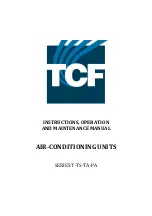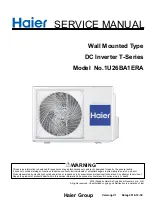
CyberAiR DX Floor Mounted IOM Manual
WARNING
To prevent personal injury, stay clear of
rotating components as automatic controls
may start them unexpectedly. Turn off power
to the unit unless you are performing tests
that require power. With power and controls
energized, the unit could begin operating at
any time.
WARNING
A lock-out tag-out procedure should be
followed to ensure that power is not
inadvertently reconnected.
CAUTION
Never work on electrical equipment unless
another person who is familiar with the
operation and hazards of the equipment and
competent in administering first aid is nearby.
WARNING
Hazardous voltage will still be present inside
the electric box at the motor start protectors
and circuit breakers, even with the unit turned
off at the microprocessor controller. To isolate
the unit for maintenance, turn off power at the
main power disconnect switch. Always
disconnect main power prior to performing
any service or repairs.
CAUTION
Cooling coils and associated piping circuits
are
pressurized (up to 100 psi)
and sealed
when they leave the factory.
WARNING
Refrigerant is used with this equipment.
Death or serious injury may result if personnel
fail to observe proper safety precautions.
Great care must be exercised to prevent
contact of liquid refrigerant or refrigerant gas
(discharged under pressure) with any part of
the body. The extremely low temperature
resulting from the rapid expansion of liquid
refrigerant or pressurized gas can cause
sudden and irreversible tissue damage.
As a minimum, all personnel should wear
thermal protective gloves and face-
shield/goggles when working with refrigerant.
Application of excessive heat to any
component will cause extreme pressure and
may result in a rupture.
Exposure of refrigerant to an open flame or a
very hot surface will cause a chemical reaction
that
will
form carbonyl chloride
(hydrochloric/hydrofluoric acid); a highly
poisonous and corrosive gas commonly
referred to as PHOSGENE. In its natural state,
refrigerant is a colorless, odorless vapor with
no toxic characteristics. It is heavier than air
and will disperse rapidly in a well-ventilated
area. In an unventilated area, it presents a
danger as a suffocant.
Always refer to the manufacturer’s MSDS
provided with the unit.
CAUTION
Do not use cleaning solvents near open flame
or excessive heat. Wear eye protection when
blowing solvent from parts. The pressure-
wash should not exceed 30 psig. Solvent
solutions should be disposed of in
accordance with local and state regulatory
statutes.
CAUTION
Certain maintenance or cleaning procedures
may call for the use and handling of
chemicals, solvents, or cleansers. Always
refer to the manufacturer’s Material Safety
Data Sheet (MSDS) prior to using these
materials. Clean parts in a well-ventilated area.
Avoid inhalation of solvent fumes and
prolonged exposure of skin to cleaning
solvents. Wash exposed skin thoroughly after
contact with solvents.
WARNING
When performing soldering or desoldering
operations, make certain the refrigeration
system is fully recovered and purged and dry
nitrogen is flowing through the system at the
rate of not less than 1-2 CFM (.03 - .06
M³/minute).
WARNING
Do not use chloride based water conditioning
additives in condensate drain pans. This will
cause corrosion to occur on the coil fins.
1-3









































